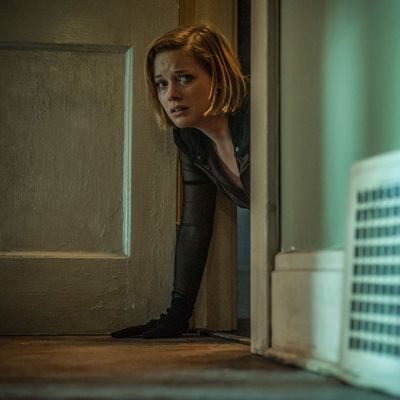
Having missed the press screenings of the horror-movie-of-the-week, Don’t Breathe, I caught the film at its first public showing in a Times Square–vicinity multiplex, and the coming attractions made me want to flee. Press screenings don’t have them, you understand, and so I was unprepared for the impact of five horror-picture trailers, one after another, each cut the same way and building to the same fortissimo crash followed by quivery titles that are supposed to make you think, “Oooh, scary” but in my case made me suppress a yawn. I felt I’d already had my shitty multiplex horror experience and didn’t need to stick around for the main feature.
I’m glad I stayed, though — not because Don’t Breathe has a particularly original premise or cool subtext, but because it’s visually resourceful and honest in how it sets up and delivers on its shocks. There isn’t a single false scare. There isn’t, come to think of it, a scare that doesn’t set up another scare down the road in the manner of a good gag writer — horror and slapstick being sibling-close, as Don’t Breathe’s co-producer and proud Three Stooges fan Sam Raimi would be the first to tell you.
The director is the Uruguay-born Fede Alvarez, who made the 2013 remake of Raimi’s The Evil Dead that many people (including Raimi) liked. I found its slickness offensive: If you’re going to replicate The Evil Dead experience, at least show some respect for its scrappy, shoestring origins. In the early scenes of Don’t Breathe, Alvarez’s style is too arty and fractured to pull you in, and his characters — three young hoods who have an inside track on house keys and burglar-alarm codes and make a point of stealing only medium-priced, easily fenced items — aren’t very winning.
But then we see the blonde, intensely blue-eyed young woman, Rocky (Jane Levy, who here looks like a haggard Reese Witherspoon), wilt under the mockery of her slatternly mother and her mother’s latest boyfriend. We see how she takes care of her vulnerable little sister and needs money to take the girl away. (They’re in Detroit.) And Levy is a very sympathetic actress. So we forgive Rocky much. We also forgive one of her partners, Alex (Dylan Minnette), because he’s visibly conflicted and chiefly onboard because he’s in love with Rocky. We don’t forgive Rocky’s boyfriend, Money (Daniel Zovatto), because he’s an obnoxious macho lunkhead — and goes by the name “Money.”
Their target — the big score intended to end their spree — is the one intact house in a ravaged, abandoned Detroit neighborhood. Its owner is an ex-soldier (Stephen Lang) who was blinded in Iraq and became a shut-in after his precious daughter was hit and killed by a driver who was subsequently acquitted. Already we’re losing sympathy for our protagonists, who by rights should leave this poor man alone. Hasn’t he had enough pain? It isn’t long, though, before the target house becomes a chamber of horrors — and we’re back on Rocky and Alex’s side in wanting to call the whole thing off.
Along with his cinematographer, Pedro Luque, and production designer, Naaman Marshall, Alvarez proves that you can turn a finite set of ordinary rooms, doors, windows, and staircases into a mythic labyrinth. The framing is subtly off-center, the camera angles shrink the space to the point of suffocation, and the colors (greens, reds, a rank yellow) are expressionistic without being too showy about it. In one scene, the lights go out and the world is suddenly gray and ill-defined, as in a bad video, and the characters’ pupils turn huge and off-white — except for the blind man’s, whose orbs are ragged-edged and glowing.
Lang — best known as the embodiment of psychotic military colonialism in Avatar — moves haltingly but with bursts of speed. His head tilts to listen, his nose lifts to smell, and his biceps and triceps seem to ripple as he waits, with military discipline, for his prey to make themselves apparent. Viewed in a hazy half-light, he could be the giant in Jack and the Beanstalk, another tale of an interloper looking to steal what isn’t his. Or a vengeful Tiresias. Or, at his most bloodcurdling, Goya’s Saturn biting the head off one of his children.
It should be said that Alvarez’s set-ups are better than his payoffs, which are often hard to see, and that, in the end, this is yet another movie about people running away from a monster for an hour and change. But how and where they run as well as from what (there’s also a slobbery Cujo-dog that pops up when you least expect it) is always up for grabs. And Don’t Breathe is a rare horror film in which you want to scream the title over and over — when the blind soldier stands a few feet from his quarry, receptive to every air current, bone creak, and heartbeat.


